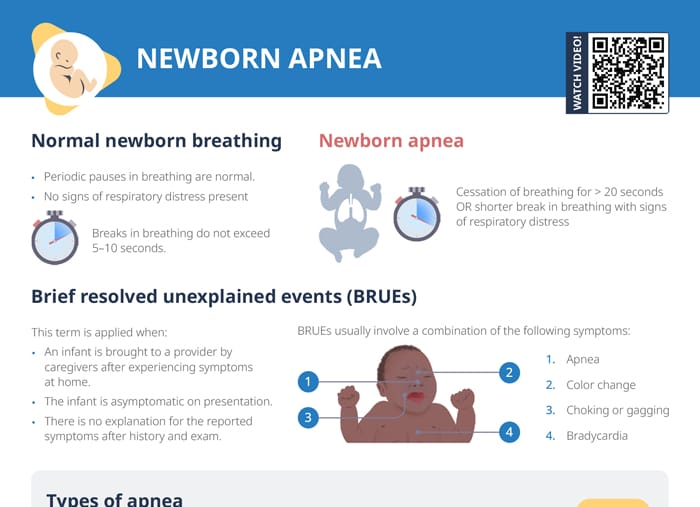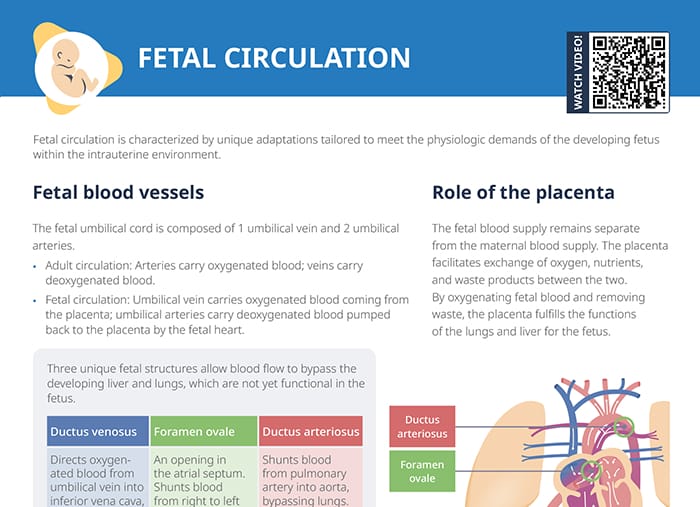What is fetal circulation?
Fetal circulation is characterized by unique adaptations tailored to meet the physiologic demands of the developing fetus within the intrauterine environment.
The fetal umbilical cord is composed of 1 umbilical vein and 2 umbilical arteries. In adult circulation, arteries carry oxygenated blood and veins carry deoxygenated blood. In contrast, the umbilical vein of the fetus carries oxygenated blood coming from the placenta. The umbilical arteries carry deoxygenated blood pumped back to the placenta by the fetal heart.
Three unique fetal structures allow blood flow to bypass the developing liver and lungs, which are not yet in the fetus:
Ductus venosus
The ductus venosus directs oxygenated blood from the umbilical vein into the inferior vena cava, bypassing the liver.
Foramen ovale
The foramen ovale is an opening in the atrial septum that shunts blood from the right to the left atrium, bypassing the lungs.
Ductus arteriosus
The ductus arteriosus shunts blood from the pulmonary artery into the aorta, bypassing the lungs.
Fetal blood circulation steps
- Oxygenated blood from the placenta enters the fetus through the umbilical vein. Most of this blood bypasses the liver via the ductus venosus, entering the inferior vena cava.
- In the heart, blood flows from the right atrium to the left atrium through the foramen ovale, skipping the lungs (which aren’t used for gas exchange in utero).
- Blood entering the right ventricle is mostly diverted from the pulmonary artery to the aorta through the ductus arteriosus. This system ensures oxygenated blood is distributed to the fetus’s vital organs.
Related videos
Role of the placenta
The fetal blood supply remains separate from the maternal blood supply while the placenta facilitates exchange of oxygen, nutrients, and waste products between the two. By oxygenating fetal blood and removing waste, the placenta fulfills the functions of the lungs and liver for the fetus.
Neonatal transition
A series of rapid circulatory changes occur in the transition to extrauterine life:
- As the lungs expand with each neonatal breath, pulmonary pressure drops.
- This shift in pressure gradient establishes the pulmonary circulation and closes the foramen ovale and ductus arteriosus shunts.
- Cessation of placental blood flow and clamping of the umbilical cord cause the ductus venosus to collapse.
- Oxygen levels increase and the mature circulatory pattern is established.
Persistent fetal circulation
Persistent fetal circulation, also known as persistent pulmonary hypertension of the newborn (PPHN), is a condition where a newborn’s circulation fails to adapt correctly to extrauterine life and continues to bypass the lungs as it did in utero.
This means the blood flow doesn’t adapt to breathing outside the womb, resulting in insufficient oxygenation of the blood. The foramen ovale and ductus arteriosus, which normally close after birth, remain open, leading to the mixing of oxygenated and deoxygenated blood. This condition requires prompt medical intervention to ensure adequate oxygen supply to the baby’s organs.

